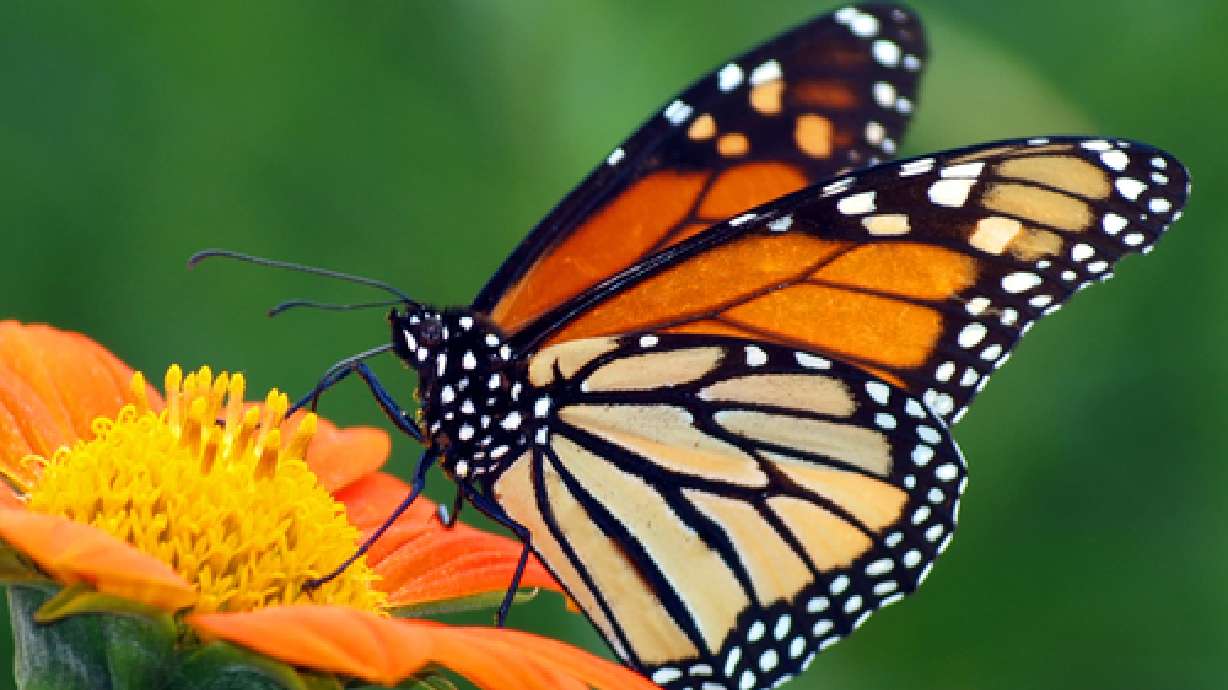Estimated read time: 4-5 minutes
This archived news story is available only for your personal, non-commercial use. Information in the story may be outdated or superseded by additional information. Reading or replaying the story in its archived form does not constitute a republication of the story.
Planting for Butterflies
Something I always enjoy seeing in my yard are the colorful wings of a butterfly as it flutters by. And as fall gets closer, it's that time of year to again plant in your yard due to cooler weather. You can encourage butterflies to enter your landscape more frequently by purchasing and planting various plants that butterflies like to feed on.
Spring or fall, to attract butterflies you will need to plant both nectar and host plants. Butterflies generally lay eggs on the host plants that their young feed on. Nectar plants are fed on by adult butterflies. Picking nectar plants that are colorful and that flower most of the season will ensure butterfly visits all season long! Additionally, to attract as many butterflies as possible and to maximize the number of eggs laid, place host and nectar plants in close proximity. This also minimizes the risk that butterflies will lay eggs on plants that the young cannot feed on.
To maintain a tidy looking landscape put host plants behind other plants where they are mostly out of view. This way chew marks on leaves from the larvae will be out of view. This will also keep the future butterfly larvae protected from birds and weather.
Some of the most common butterflies in Northern Utah are Monarchs, Swallowtails, Frittilarys and Skippers. Monarchs, Swallowtails and Frittilarys tend to have more extravagant wings with detailed patterns and colors ranging from muted browns and blacks to bright orange and blues. Their grubs are additionally usually colorful. Some also have fur or spikes to detract predators from eating them.
Skippers, on the other hand, look more like moths in their wing shape and color. They have small, common looking grubs which are usually only one solid color (green, tan, or brown) with a hard looking head for eating leaves.
Nectar Plants
Plants that attract more than one type of butterfly have colorful flowers and strong, fragrant nectar. An example of some of these includes milkweeds, butterfly weeds and butterfly bush. You can feel assured planting any of these to attract many varieties of butterfly in your area, including the ones listed below. Other plants that attract multiple species in Utah are as follows: purple cone flower, asters, late flowering boneset, Brazilian verbena, globe amaranth, Joe-Pye weed, purple coneflower, black-eyed Susan, mist flower, marigold, zinnia, white clover, bloodflower, fleabane and goldenrod.
Otherwise, here is a list of plants by butterfly species that will attract that particular butterfly:
• American Lady: dogbane, privet, salvia "Blue Bedder," and showy coneflower
• Anise Swallowtail: fennel, parsley, rue
• Black Swallowtail: oregano, privet, bergamot
• Common Buckeye: chickory, gumweed, tickseed, sunflower, dogbane, peppermint
• Great Spangled Fritillary: garlic, chives, dogbane
• Gorgon Checkerspot: Nectar from Yellow flowers such as goldenrod
• Monarch: blue cardinal flower, heath, heliotrope, lantana, milkweed, mustard greens, oriental Lilies, tithonia (Mexican Sunflower), wingstem
• Morning Cloak: oak tree sap, rotting food, occasionally nectar
• Painted Lady: cosmos, heliotrope
• Pearl Crescent: common dandelion, dogbane, garlic, chives, sedum (Autumn Joy), shepherd's needle, tickseed, winter cress
• Pipevine Swallowtail: honeysuckle, thistle
• Red Admiral: Abelia, lantana, privet,
• Red spotted Purple: lantana
• Two tailed Swallowtail: thistle, lilac
• Variegated Fritillary:, oregano, red clover, zinnia
• Weidemeyer's admiral: tree sap, carrion, flower nectar
• Western Tiger Swallowtail: thistles, abelia, zinnia, and yerba santa.
Host plants
These same butterflies will lay their eggs on host plants. Here's a list of some of their common host plants.
• American Lady: Sunflower, pearly everlasting, plantain-leaved pussy toes, wormwood, ironweed, and burdock
• Anise Swallowtail: sweet fennel, rue
• Black swallowtail: dill, parsley, fennel, rue, carrot
• Common Buckey: snapdragon, plantains, ruellia
• Edwards fritillary: Nuttall's violet and other violets
• Great Spangled Fritillary: Various violet species
• Gorgone checkerspot: sunflowers, crosswort, black-eyed Susan, aster
• Monarch: milkweed
• Mourning cloak: willow, aspen, cottonwood, elm
• Painted Lady: thistle, hollyhock, sunflower
• Pearl Crescent: asters
• Pipevine Swallowtail: pipevine
• Red Admiral: nettle, false nettle, pellitory
• Red-Spotted Purple: wild cherry, oak, poplar, hawthorn, willow, birch, aspen
• Two-tailed swallowtail: green ash, chokecherry, hop tree
• Variegated fritillary: pansy, may apple, violets, purslane, stonecrop, moonseed
• Weidemeyer's admiral: willow, aspen, cottonwood, ocean spray, shadbush
• Western tiger swallowtail: willow, cottonwood, chokecherry
Several other things to keep in mind when attracting butterflies --You may have seen a butterfly spreading its wings out as if it was relaxing in the sun. This is partly because butterflies are cold blooded. Placing rocks in your landscape will keep those butterflies in your yard happy and warm. Butterflies also like to congregate around pools. Placing a shallow bird bath outdoors with fruit in it is another easy way to attract butterflies in the area to your yard.
Some butterflies, like monarchs, migrate so don't be discouraged it they fly away and you don't see them for a while or they don't come back. Remember that having a lot of different flowers for the butterflies to choose from will keep attracting many varieties back into your yard all season long.
It is important to know what butterflies you can actually attract into your yard. For more information on butterflies in your area visit butterfliesandmoths.org
For info on specific plants and what butterflies they attract visit here








